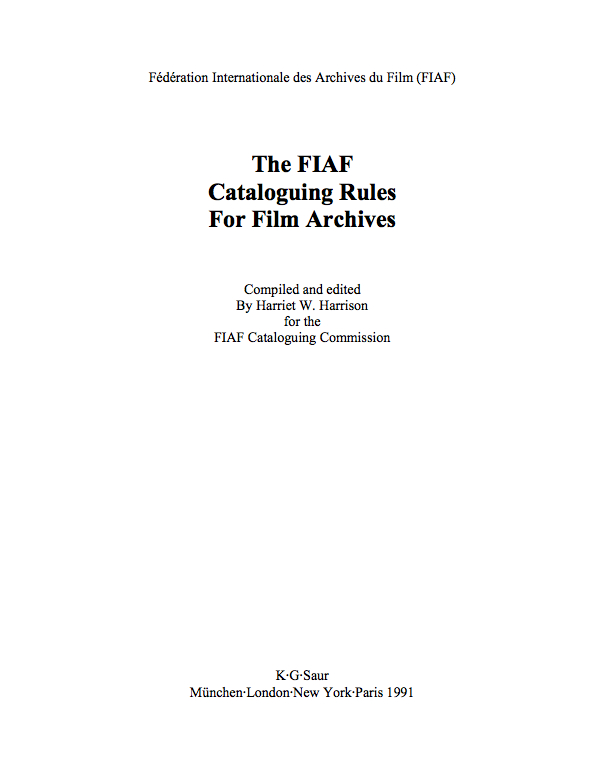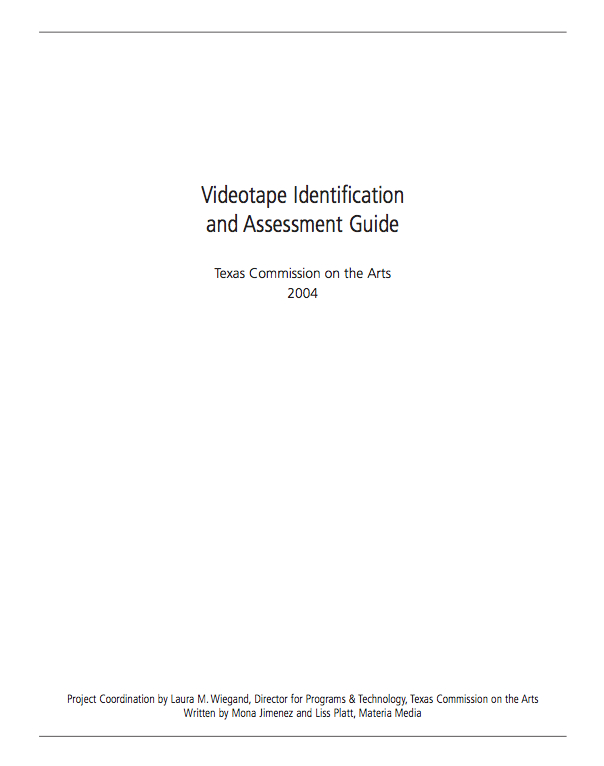Resource Guide Homepage
Resource Guide Homepage
Documentation
Documentation is the process of gathering and organizing information about a work, including its condition, its contents, and the actions taken to preserve it.
Inventory
The first stage of any preservation project is assessing the needs of the item(s) in question. For a collection with multiple titles, a basic inventory is a critical step in this process. It would be ideal to catalog a collection fully in the early stages of preservation work, but this is not always feasible or practical. Instead, a basic item-level inventory, with information gathered on paper or in a spreadsheet using software such as Excel, is a good place to start.
Minimum information in an inventory should include:
· title
· total number of tapes
· number of tapes by format (i.e. 3/4", VHS, etc.)
· age range of tapes
· basic information about each tape's condition
Note: Many collections contain obsolete videotapes in formats that are not always identifiable by non-experts. It is these obscure tapes that usually need the most attention; an accurate description of their formats is essential. For more information on videotape format identification, refer to the following valuable website:
*The Texas Commission on the Arts Videotape Identification and Assessment Guide (see document below). Visit http://www.arts.texas.gov/ to learn more about the Texas Commission on the Arts.
In the process of doing this inventory, be sure to watch out for particularly damaged or visibly deteriorated tapes. Also note the overall composition of the collection. Are there master tapes that are clearly labeled as such? Are there multiple copies of the same title? What kinds of tapes are there? With this basic information, a clearer picture of preservation needs emerges and it is now possible to begin estimating costs for preserving part or all of a collection. This information is also critical when approaching funders, who invariably want a clear sense of a project's scope.
Cataloging
When discussing the creation of complete catalog records for videotapes, one critical point must be kept in mind: since cataloging requires that a tape be viewed to determine its complete content, creators, etc., it should never be done on damaged or deteriorated tapes. Instead, cataloging should be done after preservation work, by viewing access copies of the preserved tape. Cataloging can be surprisingly complicated. Numerous standards have been set by librarians and archivists to keep catalog records consistent between various institutions and databases. Before building a database of catalog records, it is helpful to consult an archivist or librarian to be sure that you are gathering the right information-and organizing it properly-the first time around. An important part of cataloging is the use of a consistent vocabulary. The generally used standard for cataloging moving image material is Archival Moving Image Materials: A Cataloging Manual, 2nd edition, colloquially known as AMIM-2. It is available at many research and university libraries, and gives detailed standards for describing everything from tape format to title variations. For thorough item-level documentation, consider the IMAP Cataloging Template, a user-friendly template designed for smaller, independent institutions and individuals that can be used with FileMaker Pro or Microsoft Access. A full tutorial can be found on the IMAP website.
A basic catalog record, whether paper, spreadsheet, or database, should include:
· artist
· unique identification number
· date of production
· color or black & white
· sound or silent
· running time
· format
· generation
· tape stock
· if it is part of a series
· notes written on the container or reel or on any paper found inside the container
· physical condition of the tape
· tape's storage history, if known
Rules for cataloging developed by The International Federation of Film Archives (FIAF) is available at the bottom of this page. Visit The International Federation of Film Archives to learn more.
Numbering
Critical to the cataloging process is the use of a unique identifying number for each individual item. Some collections may have been carefully numbered already; this numbering system can often be maintained (and should always be recorded in the database.) If the tapes are not thoroughly or consistently numbered, new numbers should be assigned. The numbering system should be as simple as possible. A basic numbering system can describe the collection or creator, assign a number, and give details about format or generation. For example, the first tape in the Dolores Smith collection, an edited master, could be numbered: DS-00001-M The various conventions for numbering should be determined in advance, as should conventions for writing out the number (e.g., the use of hyphens, etc.) Consistency is critical; once a system has been established, do not change it unless absolutely necessary.
Labeling
Place acid-free labels on both the container and the tape. Some archivists prefer labeling tapes and cases directly with archival safe permanent markers, as labels can dry out and fall off. Labels should include:
· title
· artist
· date
· generation
· unique identification number
The FIAF Cataloguing Rules For Film Archives
http://www.fiafnet.org/~fiafnet/uk/publications/fep_cataloguingRules.html

